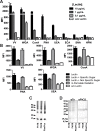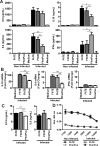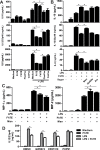Glycans from Fasciola hepatica Modulate the Host Immune Response and TLR-Induced Maturation of Dendritic Cells
- PMID: 26720149
- PMCID: PMC4697847
- DOI: 10.1371/journal.pntd.0004234
Glycans from Fasciola hepatica Modulate the Host Immune Response and TLR-Induced Maturation of Dendritic Cells
Abstract
Helminths express various carbohydrate-containing glycoconjugates on their surface, and they release glycan-rich excretion/secretion products that can be very important in their life cycles, infection and pathology. Recent evidence suggests that parasite glycoconjugates could play a role in the evasion of the immune response, leading to a modified Th2-polarized immune response that favors parasite survival in the host. Nevertheless, there is limited information about the nature or function of glycans produced by the trematode Fasciola hepatica, the causative agent of fasciolosis. In this paper, we investigate whether glycosylated molecules from F. hepatica participate in the modulation of host immunity. We also focus on dendritic cells, since they are an important target of immune-modulation by helminths, affecting their activity or function. Our results indicate that glycans from F. hepatica promote the production of IL-4 and IL-10, suppressing IFNγ production. During infection, this parasite is able to induce a semi-mature phenotype of DCs expressing low levels of MHCII and secrete IL-10. Furthermore, we show that parasite glycoconjugates mediate the modulation of LPS-induced maturation of DCs since their oxidation restores the capacity of LPS-treated DCs to secrete high levels of the pro-inflammatory cytokines IL-6 and IL-12/23p40 and low levels of the anti-inflammatory cytokine IL-10. Inhibition assays using carbohydrates suggest that the immune-modulation is mediated, at least in part, by the recognition of a mannose specific-CLR that signals by recruiting the phosphatase Php2. The results presented here contribute to the understanding of the role of parasite glycosylated molecules in the modulation of the host immunity and might be useful in the design of vaccines against fasciolosis.
Conflict of interest statement
The authors have declared that no competing interests exist.
Figures







Similar articles
-
Fasciola hepatica glycoconjugates immuneregulate dendritic cells through the Dendritic Cell-Specific Intercellular adhesion molecule-3-Grabbing Non-integrin inducing T cell anergy.Sci Rep. 2017 Apr 24;7:46748. doi: 10.1038/srep46748. Sci Rep. 2017. PMID: 28436457 Free PMC article.
-
Fasciola hepatica Extracellular Vesicles isolated from excretory-secretory products using a gravity flow method modulate dendritic cell phenotype and activity.PLoS Negl Trop Dis. 2020 Sep 8;14(9):e0008626. doi: 10.1371/journal.pntd.0008626. eCollection 2020 Sep. PLoS Negl Trop Dis. 2020. PMID: 32898175 Free PMC article.
-
Major secretory antigens of the helminth Fasciola hepatica activate a suppressive dendritic cell phenotype that attenuates Th17 cells but fails to activate Th2 immune responses.Infect Immun. 2010 Feb;78(2):793-801. doi: 10.1128/IAI.00573-09. Epub 2009 Nov 16. Infect Immun. 2010. PMID: 19917714 Free PMC article.
-
An Evaluation of the Fasciola hepatica miRnome Predicts a Targeted Regulation of Mammalian Innate Immune Responses.Front Immunol. 2021 Jan 29;11:608686. doi: 10.3389/fimmu.2020.608686. eCollection 2020. Front Immunol. 2021. PMID: 33584684 Free PMC article. Review.
-
Fasciola hepatica, TGF-β and host mimicry: the enemy within.Curr Opin Microbiol. 2018 Dec;46:80-85. doi: 10.1016/j.mib.2018.09.002. Epub 2018 Oct 11. Curr Opin Microbiol. 2018. PMID: 30317150 Review.
Cited by
-
Transcriptome-wide analysis of filarial extract-primed human monocytes reveal changes in LPS-induced PTX3 expression levels.Sci Rep. 2019 Feb 22;9(1):2562. doi: 10.1038/s41598-019-38985-x. Sci Rep. 2019. PMID: 30796272 Free PMC article.
-
Exosome-Depleted Excretory-Secretory Products of the Fourth-Stage Larval Angiostrongylus cantonensis Promotes Alternative Activation of Macrophages Through Metabolic Reprogramming by the PI3K-Akt Pathway.Front Immunol. 2021 Jul 23;12:685984. doi: 10.3389/fimmu.2021.685984. eCollection 2021. Front Immunol. 2021. PMID: 34367145 Free PMC article.
-
Recent Progress in the Development of Liver Fluke and Blood Fluke Vaccines.Vaccines (Basel). 2020 Sep 22;8(3):553. doi: 10.3390/vaccines8030553. Vaccines (Basel). 2020. PMID: 32971734 Free PMC article. Review.
-
Fasciola hepatica Immune Regulates CD11c+ Cells by Interacting with the Macrophage Gal/GalNAc Lectin.Front Immunol. 2017 Mar 15;8:264. doi: 10.3389/fimmu.2017.00264. eCollection 2017. Front Immunol. 2017. PMID: 28360908 Free PMC article.
-
Timing of Transcriptomic Peripheral Blood Mononuclear Cell Responses of Sheep to Fasciola hepatica Infection Differs From Those of Cattle, Reflecting Different Disease Phenotypes.Front Immunol. 2021 Sep 20;12:729217. doi: 10.3389/fimmu.2021.729217. eCollection 2021. Front Immunol. 2021. PMID: 34616397 Free PMC article.
References
-
- Dowling D, Hamilton C, Donnelly S, La Course J, Brophy P, Dalton J, et al. Major secretory antigens of the helminth Fasciola hepatica activate a suppressive dendritic cell phenotype that attenuates Th17 cells but fails to activate Th2 immune responses. Infect Immun. 2010;78:793–801. 10.1128/IAI.00573-09 - DOI - PMC - PubMed
Publication types
MeSH terms
Substances
LinkOut - more resources
Full Text Sources
Other Literature Sources

